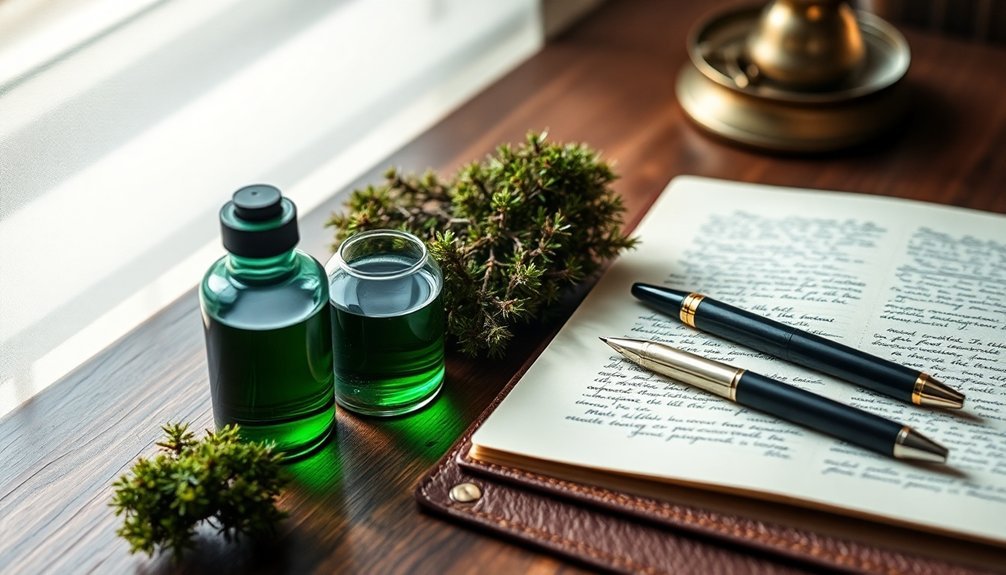Start with a balanced ratio of 55% oakmoss to 45% vetiver, diluting both to 10% solutions before blending. You'll want to test your combinations on scent strips, keeping detailed notes of the results and fragrance evolution over several days. Don't rush the process – allow your blends to rest and develop their full potential. There's much more to discover about this earthy, complex combination of forest essences.
The Art of Balancing Earth and Forest

While creating enchanting fragrances often requires skill and precision, blending vetiver and oakmoss offers a unique opportunity to capture nature's most grounding elements.
You'll find success by starting with a balanced ratio of 55% oakmoss to 45% vetiver, creating a harmonious foundation that evokes the essence of a forest floor.
To achieve the perfect blend, begin by diluting both vetiver and oakmoss to 10% solutions. This dilution allows you to test the earthy aroma without overwhelming your senses.
As you work with these base notes, you'll discover their remarkable staying power and complexity.
Consider enhancing your fragrance by introducing complementary middle and top notes. The deep, woody characteristics of this blend provide an excellent canvas for experimenting with floral or citrus elements, adding layers of sophistication to your creation.
Mastering the Perfect Ratio
When crafting the perfect vetiver and oakmoss blend, understanding precise ratios becomes your key to success. For these essential oils to blend well together, you'll want to start with a classic 30-50-20 ratio: 30% top notes, 50% middle notes, and 20% base notes.
If you're seeking a deeper, more sophisticated fragrance, try shifting to 55% base notes, with 20% middle notes and 25% top notes.
As you're experimenting, start small with 5-20 drops total to avoid wasting precious oils. You'll discover the therapeutic benefit of patience – let your blend rest for several days to achieve its full potential.
Don't forget to maintain detailed documentation of your successful ratios. This practice guarantees you can replicate your favorite blends consistently.
Testing and Documentation Techniques

Testing and documenting your vetiver and oakmoss blends builds directly on your ratio mastery. Start by using scent strips to assess different combinations, then maintain detailed records of each blend's ratios and characteristics in your notebook.
You'll want to track how your fragrance evolves over several days, as the scent profile can change greatly with time.
- Label storage bottles with reference numbers that match your documentation for seamless organization
- Test multiple dilutions (10% and 1%) to better understand your blend's complexity
- Document specific ratios and characteristics for each successful combination
- Record the evolution of your fragrance over time to anticipate how it will develop
Remember to focus on systematic testing and thorough documentation – these practices will help you replicate your most successful blends consistently.
Frequently Asked Questions
What Does Vetiver Blend Well With?
You'll find vetiver blends perfectly with woody oils like cedarwood and sandalwood, floral notes such as jasmine and rose, citrus oils including bergamot, spicy oils like black pepper, and herbal scents like basil.
What Does Vetiver and Oakmoss Smell Like?
You'll experience a deep, earthy fusion where vetiver's warm, smoky sweetness meets oakmoss's forest-floor dampness. Together, they create a rich, complex aroma that's both grounding and fresh, like walking through a misty woodland.
What to Layer Vetiver With?
You'll get the best results layering vetiver with florals like jasmine or rose, citrus notes like bergamot, woody scents like sandalwood, or spicy elements like cardamom. Each pairing creates uniquely beautiful combinations.
Is Vetiver Scent Masculine or Feminine?
While vetiver's traditionally considered masculine due to its earthy, woody notes, you'll find it's actually unisex. It can lean feminine when blended with florals or citrus, so it really depends on the fragrance composition.
In Summary
You've now got the essential tools to create stunning vetiver and oakmoss blends. Start with a 2:1 ratio, keep detailed notes of your experiments, and trust your nose as you fine-tune the balance. Remember that patience is key – these deep, earthy notes need time to develop. Don't be afraid to adjust and explore until you find your perfect signature blend.





Leave a Reply